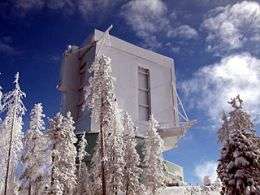LBT Captures Extremely Faint Light With Its First Mirror and Camera

It was a small, barely visible glow among a myriad brighter stars and galaxies in the night sky.
But to astronomers who recorded the faint light with the Large Binocular Telescope (LBT) on Feb. 21, it was gratifying proof that the first 8.4-meter mirror and camera on what soon will be the world's most powerful telescope -- the twin-mirrored telescope on Mount Graham, Ariz. -- delivers science as promised.
University of Notre Dame astronomer Peter Garnavich headed an international team of observers who with the LBT's first primary mirror and its "blue" camera captured a data point on the light curve of the optical afterglow from a gamma ray burst that exploded almost a month earlier.
The observation is a milestone -- the LBT Observatory's first published scientific result. The result was reported in an online newsletter for scientists who study gamma ray bursts, which are very short-lived phenomena.
Only an 8-meter class telescope can see such very faint light from a 26th-magnitude object, or a hundred million times fainter than can be seen with the unaided eye, said Xiaohui Fan of the University of Arizona's Steward Observatory, a member of the observing team. Optical light from the afterglow of the Jan. 25 gamma ray burst came from about 10 billion light years away.
"The LBT is now going deep into the sky and getting data of the good quality that we thought we would get," Fan said. "Even with an 8-meter telescope, it takes about a half hour to gather light on an object that faint. From the telescope technical point of view, this is good news for us just because the accuracy of this measurement is very close to what was actually predicted this system could deliver. The system is working fine."
The team took 10 "dithered" 200 second exposures instead of a single 2,000 second exposure for the observation. The dithering technique moved the telescope slightly between 10 individual, 200-second exposures to cut down on detector noise. Astronomers then average the results.
The observation is part of the "science demonstration" program that the LBT began in January. A committee representing all LBT partners selected 30 programs that will demonstrate the science LBT can do. Astronomers from partner institutions use the LBT in teams, learning to command the telescope and sharing the risks of technical downtime. Individual investigators will use the telescope for their specific projects later.
The Large Binocular Telescope is the first of the next generation of extremely large telescopes. The telescope achieved first light with the first of its two 8.4-meter (27.6 feet) primary mirrors on Oct. 12, 2005. It will see "first binocular light" -- light from both huge mirrors on a single mount -- later this year.
Located 10,500 feet high on Mount Graham in southeastern Arizona, the $120 million LBT will have a collecting area equivalent to an 11.8-meter (39-foot) circular aperture. Combining light beams from the two primary mirrors will give the LBT the resolution of a 22.8-meter (about 75-foot) telescope.
The LBT is an international collaboration among institutions in the United States, Italy and Germany. The partners are:
- The University of Arizona on behalf of the Arizona university system
- Italy's Instituto Nazionale di Astrofisica
- Germany's LBT Beteiligungsgesellschaft representing the Max Planck Institute, the Astrophysical Institute (Potsdam) and Heidelberg University
- The Ohio State University and The Research Corporation, which provides telescope access to The University of Notre Dame, University of Minnesota and University of Virginia
Source: University of Arizona





















